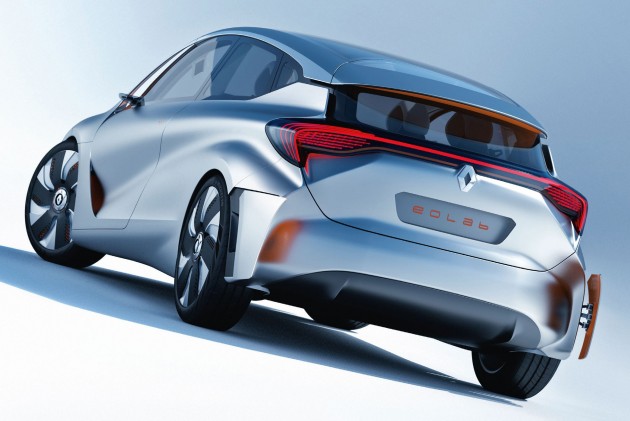
This is the Renault EOLAB, a supermini concept with a single-minded focus on efficiency. Set to debut at the Paris Motor Show in a couple of days, it is claimed to be able to achieve a fuel consumption figure of just 1 litre per 100 km, as well as emitting just 22 grams of carbon dioxide per kilometre on the NEDC cycle.
Deriving its odd name from Aeolous, god and ruler of winds in Greek mythology, as well as the word "laboratory", the EOLAB is said to feature nearly 100 technical innovations that will gradually make their way to production Renaults before the year 2020. The car is also the firm's realistic vision of a B-segment hatch that will be produced within the next 10 years.
To achieve the claimed fuel economy, engineers focused on three key areas. The first was aerodynamics – the EOLAB achieves a drag coefficiency figure of just 0.235 Cd (30% lower than the current Clio), thanks to a flat underbody, an active front spoiler, narrow wheels that close up when brake cooling is not needed, movable aerodynamic flaps at the rear, as well as a ride height that lowers by 25 mm at speed.

Secondly, weight has been pared down to a minimum, with the extensive use of aluminium, magnesium, thermoplastics and a supremely high tensile variant of steel called Very Very High Elastic Limit (VVHEL) steel shaving 130 kg from the body alone. Aluminium has also replaced many of the heavy steel suspension components, while the brakes were able to be made smaller and more compact thanks to the lighter body.
That's not all – the glass is now 1.5 mm thinner, the rear windscreen is made of polycarbonate, the seats and the interior fittings and trim have been made lighter and the electrical equipment now weighs 20 kg less than before. Altogether the car weighs 400 kg less compared to an equivalent Clio, sitting at 955 kg.

Last but not least, there's Renault's Z.E. Hybrid powertrain, combining a 40 kW (54 hp), 200 Nm electric motor, a 6.7 kWh lithium ion battery and a 75 hp, 95 Nm 1.0 litre petrol three-pot. Combining these components is a clutchless three-speed transmission – the first two ratios are reserved for the electric motor, the top ratio for the internal combustion engine (ICE).
The plug-in hybrid powertrain works in two modes. The "weekday" mode uses electric power as much as possible (the EOLAB has an all-electric range of 60 km), only engaging the ICE beyond 120 km/h. The second "weekend" function activates the engine at a lower speed and also makes use of energy recuperation under braking to boost range and performance.



No comments:
Post a Comment